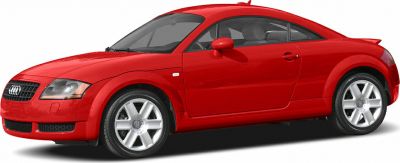 1999 Audi TT Coupe (8N) Dimensions, Size & Specs
1999 Audi TT Coupe (8N) Dimensions, Size & SpecsMeasurements of the 1999 Audi TT Coupe, engineered for optimal performance and comfort
| Dimensions | |
|---|---|
| Length: | 4041 mm159.1 in13.3 ft |
| Width: | 1764 mm69.4 in5.8 ft |
| Height: | 1346 mm53.0 in4.4 ft |
| Trunk Capacity: | 220-270 liter7.8-9.5 cu ft |
| Trunk Capacity (Max): | 490-540 liter17.3-19.1 cu ft |
| Weight Specifications | |
| Curb Weight: | 1240-1395 kg2734-3075 lbs |
| Maximal permitted Weight: | 1610-1765 kg3549-3891 lbs |
| Roof Load: | 75-100 kg165-220 lbs |
| Tire Specifications | |
| Rims Sizes: | 16-inch rims:
|
| Tire Sizes: |
|
The Audi TT Coupe (8N), produced between 1998 and 2000, represents the first generation of Audi's iconic compact sports coupe. Designed with a sleek, aerodynamic silhouette, the TT Coupe measures 4041 mm (159.1 inches) in length, 1764 mm (69.4 inches) in width, and has a height ranging between 1345 mm and 1346 mm (52.9 to 53 inches), delivering a sporty yet practical profile. With a curb weight varying between 1240 kg and 1395 kg (2734 to 3075 lbs), this generation balances lightweight agility with solid build quality. The maximum allowable weight ranges from 1610 kg to 1765 kg (3548 to 3891 lbs), ensuring good load capacity without compromising driving dynamics. Storage practicality is enhanced by its luggage capacity, which spans from 220 liters to 270 liters (7.8 to 9.5 cubic feet) under normal conditions. Folding down the rear seats increases this cargo space significantly to between 490 liters and 540 liters (17.3 to 19.1 cubic feet), making the TT Coupe versatile for everyday use and weekend getaways. The vehicle supports a roof load between 75 kg and 100 kg (165 to 220 lbs), useful for roof boxes or sports equipment carriers. The TT Coupe rides on rim sizes of either 7J x 16 or 7.5J x 17, paired with tire dimensions of 205/55 R16 or 225/45 R17, providing a firm grip and sporty handling characteristics. Overall, the Audi TT Coupe (8N) is a compact, stylish, and practical coupe that combines performance with everyday usability, making it a popular choice among enthusiasts of sporty yet refined cars.
Discover the standout features that make the 1999 Audi TT Coupe a leader in its class
Have a question? Please check our knowledgebase first.
The Audi TT Coupe (8N), produced between 1998 and 2000, measures 4041 mm (159.1 inches) in length, 1764 mm (69.4 inches) in width, and has a height ranging between 1345 mm to 1346 mm (approximately 52.9 to 53 inches). These compact dimensions give the TT its sporty, agile coupe stance, suitable for urban and sporty driving, blending a sleek, aerodynamic profile with practical everyday usability.
The 1999 Audi TT Coupe (8N) has a curb weight varying between 1240 kg and 1395 kg (2734 to 3075 lbs). This relatively light weight for a coupe of its era aids in sharp handling, improved acceleration, and better fuel efficiency. The balanced weight distribution combined with Audi’s quattro all-wheel-drive system (in some versions) delivers enhanced road grip and dynamic driving capabilities, making it a responsive and enjoyable vehicle for sporty driving.
The Audi TT Coupe (8N) offers a luggage capacity ranging from 220 to 270 liters (7.8 to 9.5 cubic feet) with the rear seats up, sufficient for everyday use or weekend getaways. When the rear seats are folded down, the capacity significantly expands to between 490 and 540 liters (17.3 to 19.1 cubic feet), allowing for transport of larger items or additional luggage, enhancing the car's versatility despite its compact sports car nature.
Yes, the Audi TT Coupe (8N) fits comfortably into a standard residential garage. With a length of 4041 mm (159.1 inches), a width of 1764 mm (69.4 inches), and a height of approximately 1345 mm (52.9 inches), its compact size ensures ease of parking in typical garage spaces, which usually accommodate vehicles longer than 4.8 meters (about 15.7 feet) and wider than 2.4 meters (about 7.9 feet). Thus, owners should have no issues storing the TT in a standard garage.
The Audi TT Coupe (8N) is actually the first generation of the TT model line, so it does not have a predecessor within the TT lineage to compare to directly. Prior to the first-gen TT, Audi did not have a comparable compact sports coupe in its lineup. The introduction of the 8N TT in 1998 marked Audi's entry into the premium sports coupe segment with a fresh design and compact dimensions emphasizing a sporty yet practical driving experience.
When compared to similar sports coupes from the late 1990s, such as the BMW Z3 and Porsche Boxster, the 1999 Audi TT Coupe (8N) features a similar compact footprint but with a distinctive rounded, minimalist design ethos. The TT is slightly shorter and narrower than some competitors—BMW Z3 measures about 4140 mm in length and 1740 mm in width, while the Boxster is roughly 4250 mm long. The TT’s smaller dimensions and lighter weight contribute to nimble handling, making it competitive in the sporty compact coupe category.
The height of the 1999 Audi TT Coupe (8N) ranges between 1345 mm and 1346 mm (approximately 52.9 to 53 inches). This relatively low height emphasizes the car's sporty silhouette, but Audi designed the interior ergonomics carefully to maximize headroom for occupants. While taller individuals might find the space slightly cozy, average-height passengers typically find sufficient headroom combined with comfortable seating posture for sporty driving.
The Audi TT Coupe (8N) came equipped with two main rim and tire size options that complement its sporty character and driving dynamics. It features 7J x 16 inch rims paired with 205/55 R16 tires for models emphasizing comfort and everyday usability. Alternatively, sportier variants use 7.5J x 17 inch rims with 225/45 R17 tires, enhancing grip and cornering performance. These combinations strike a balance between ride quality and athletic handling.
The Audi TT Coupe (8N) roof supports a load capacity between 75 kg and 100 kg (approximately 165 to 220 lbs). This capacity accommodates roof-mounted accessories such as bike racks, roof boxes, or carriers designed for light equipment, expanding the vehicle’s versatility. However, given the car’s sporty nature and aerodynamic design, it’s advisable not to exceed these limits or install bulky equipment that could adversely affect handling or fuel efficiency.
The maximum weight, also known as the gross vehicle weight rating (GVWR), of the Audi TT Coupe (8N) ranges from 1610 kg to 1765 kg (3549 to 3891 lbs), depending on the specific trim, options, and equipment. This rating indicates the maximum permissible weight of the vehicle including passengers, cargo, and fuel. Variances typically reflect differences in engine options, drivetrain (front-wheel vs. all-wheel drive), and added features, impacting payload capacity and overall vehicle dynamics.
Discover similar sized cars.

| Production: | 2000-2006 |
|---|---|
| Model Year: | 2001 |
| Length: | 4041 mm159.1 in |
| Width: | 1764 mm69.4 in |
| Height: | 1346 mm53.0 in |
